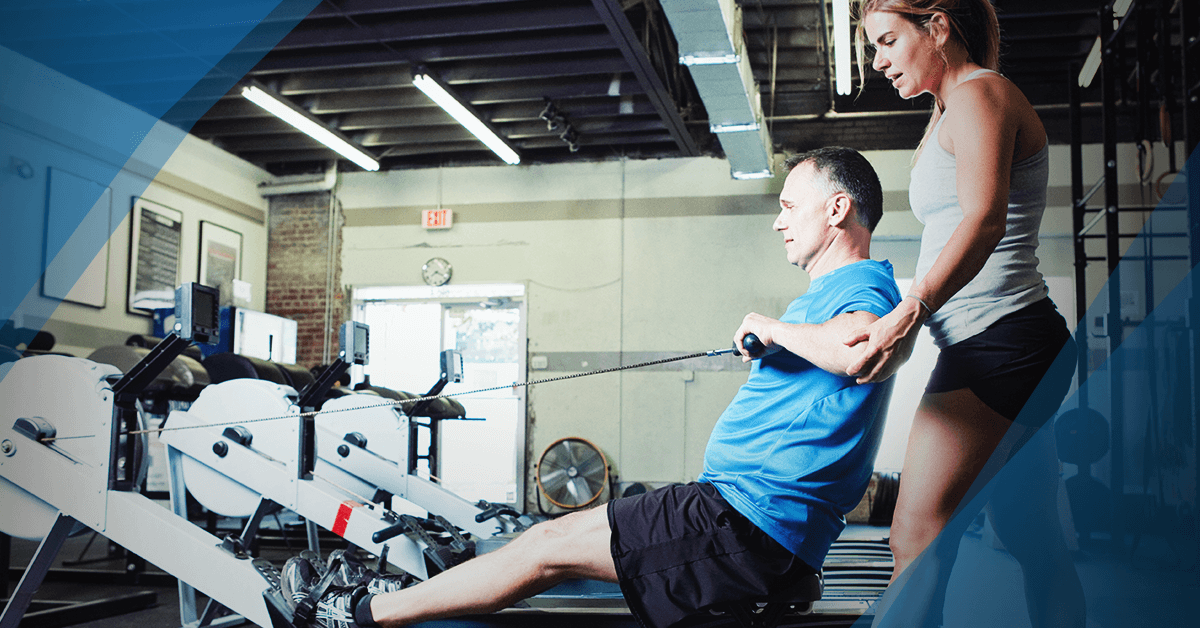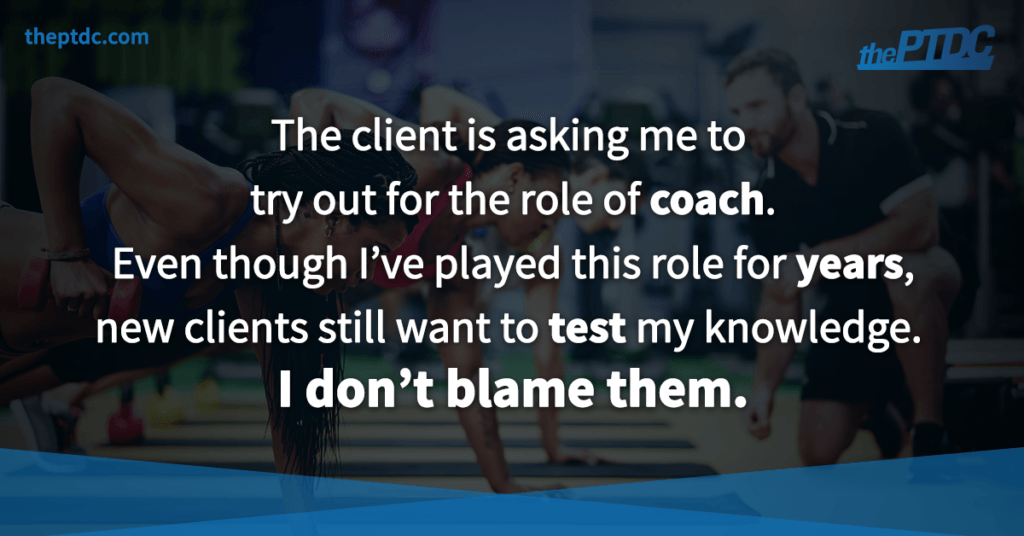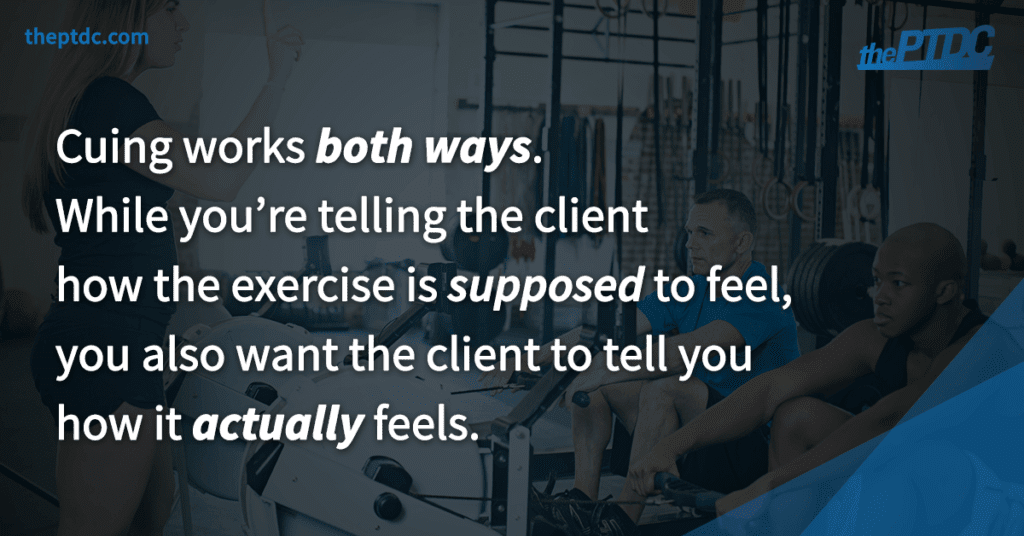It happens to me more often than I'd like to admit.
It happens when a client calls me a “young pup,” or tells me he’s been bench pressing longer than I’ve been alive.
That's when it comes back. That's when I remember the time when I was 21 years old, standing in front of a full CFL team, helping to lead a warmup during training camp, and realized that some of the people staring back at me were almost twice my age.
I had experience, education, and certification on my side—I’d been training people for five years by that point—but the looks on their faces echoed doubts I had about myself.
Moments like these are all too common for trainers who’re just starting out. For me, it was my age. For you it might be your gender, ethnicity, background, size, or shape.
The problem is the same: Clients and athletes are self-interested.
They aren’t there to pad your resume, or to provide before-and-after photos for your website. When they size you up, they’re trying to decide if you can help them reach their goals, and they’re going to challenge you.
You start to doubt your preparation, and may even wonder if you really are an imposter.
But you can put those worries to rest. The following five methods have helped me turn people who were initially skeptical into some of my most loyal and enthusiastic clients.
5 Ways to Turn Clients from Skeptical to Committed
1. Remove Conflict
I’ve had clients question every aspect of my programs, from exercise and equipment selection to sets, reps, tempo, intensity, and progression. Each time a client challenges me I have two choices:
- I can see it as a personal attack
- I can tell myself it’s an audition
The client is asking me to try out for the role of coach. Even though I’ve played this role for years, new clients still want to test my knowledge. I don’t blame them.
At my first internship, an NHL player would sometimes ask me a question. Then he’d ask my boss the same question and compare our answers. After a while, he convinced himself that I knew what I was talking about, and didn’t need to get a second opinion on everything I told him.
But it’s not only elite athletes who have questions. Every trainer, at some point, gets hit with a variation of, “Hey, I read an article last night that said cardio makes you weaker. Shouldn’t we cut it out of my program?” Our good friend Señor Google not only puts a world of information at our fingertips, it does the same for our clients. The result is that we face more questions than ever.
The PTDC founder Jonathan Goodman tells a story in his book, Ignite the Fire, about the importance of the sandwich approach to a know-it-all client.
A former client of his bought a pack of training sessions for her parents. She warned Jon that her father would be difficult to work with, and he was. A classic know-it-all, he barely let Jon introduce himself before describing his entire routine, which of course he’d designed himself.
Jon listened respectfully and took careful notes. Then he put him through an assessment that showed poor mobility and numerous imbalances, all of which probably contributed to the client’s self-described back, shoulder, and knee pain. It was immediately clear that the client’s program, the one he was so proud of, contributed in no small way to those problems. Most trainers would be tempted to point that out immediately.
Instead, Jon used the sandwich technique to bring him around. He started by describing all the positive aspects of the client’s routine. That made him receptive to the more important information about his limited mobility, and how doing hundreds of crunches every workout probably made his back pain worse. Then he finished with another compliment, this time about the client’s lifelong dedication to fitness.
You can apply the sandwich technique to lots of situations.
The sandwich technique for dealing with a know-it-all client:
- Point out something the client does well
- Follow it with the correction you need him to make
- Finish with another compliment.
Whether the client is an accomplished athlete or a grumpy old man, you’ll get much farther when you take away the potential for conflict.
2. Test, Test, Test
The key to Jon’s anecdote is the assessment before he started training the client. That assessment is also the key to showing a client how much progress she’s made. There’s nothing like progress to get a client to trust you as you move forward with her program. Here are three tests I like to use:
Strength
If I’m training an athlete, my initial tests will build up to using max or near-max weights. I’ll work up to a one-rep max on exercises that are easy to spot, like bench presses, front squats, and weighted pull-ups. We’ll go to a three-rep max on box squats and trap-bar deadlifts, if I decide to test them, and a 5RM on bent-over rows and shoulder presses.
With non-athletic clients, my goal is to work up to a “tough set” on the exercise we’re testing, rather than a true max effort. So if, for example, a client fails on the fifth rep, I consider that weight the client’s four-rep max.
I retest it by having the client do an AMRAP (as many reps as possible) set with her initial test weight. Doing 10 reps with that original 4RM weight is a great way to demonstrate how far she’s come, and makes her feel great about herself.
Cardio
My favorite cardio test is 10 minutes on an elliptical. I record the number of calories shown on the machine. I choose the elliptical because, unlike a stationary bike or treadmill, it tests both upper- and lower-body endurance. (An Airdyne is even better, if your gym has one.) It doesn’t matter if the number I get reflects the actual number of calories the client burns; I’m sure it doesn’t. But it does give us a data point to mark the total amount of work done.
I retest it by having the client see how long it takes her to reach the same number of calories. The goal, of course, is to get there in less than 10 minutes. My clients love it, and we often use the test as a cardio finisher at the end of a session.
Core stability
A friend and I came up with this for a bootcamp we ran at St. Francis Xavier University. The client starts in the push-up position, and does a single rep every 10 seconds. Most people are used to doing push-ups and planks as separate exercises. Having them hold in the push-up position between reps fatigues the core and shoulders in a way they aren’t expecting.
I had one client, a special-forces candidate, who made it five minutes. But most people who’re in decent shape will have to stop after 60 to 90 seconds.
Like the cardio test, it makes a great finisher, and lends itself to rapid progress. The first time you do it, you don’t even have to tell the client it’s a test. Make sure you record the score, and then surprise him with how much he’s improved the next time you try it.
3. Learn Your Cues
Nobody wants to hear advice from someone who isn’t good at the thing he’s telling you how to do. Showing you understand how an exercise feels to the client removes that doubt. A few sensory cues that have worked for me:
Romanian deadlift: “If you keep the bar closer to your body, you’ll feel it a bit more in the hamstrings.”
Split squat: “Dig your toes into the ground and you’ll feel your calves working.”
Bench press: “Try to break the bar. That way you’ll tuck your elbows and engage your upper-back muscles without having to think about it.” (Here are eight more cues from top coaches.)
These are predominantly internal cues, which means they encourage the client to focus on what her body does during an exercise. External cues direct her attention to the outcome of the movement—telling her to push the bar toward the ceiling during a bench press, or to show you the logo on her shirt during a deadlift.
As Travis Owen points out in this article, internal cues are best for clients who’re learning new exercises and focusing on their technique. You’ll shift to more external cues once the client has good form and you’re more focused on improving performance.
Cuing works both ways. While you’re telling the client how the exercise is supposed to feel, you also want the client to tell you how it actually feels.
I learned early in my career that you have to ask in a specific way to get the feedback you need. If you simply say, “How did that feel?” at the end of a set, 95 percent of the time the client will say “good.” Which, obviously, doesn’t give you much to go on.
Here are a few examples of how to ask more specific questions:
Trap-bar deadlift: “How does your back feel with this tempo?”
Romanian deadlift: “Does anything feel tight when you’re pushing your hips back?”
Front Squat: “How do your knees feel at that depth?”
When you want to correct a client’s form, it often helps to use a “for me” construction. So if I see a client’s knees collapse inward during a squat, I might say, “For me, when I do a squat, I sometimes feel my knees come in a bit. I like to twist my feet into the ground to get my glutes working, which helps keep my knees out.”
4. Present Problems You Can Solve
A client who’s confident enough to challenge a coach is probably pretty good at something. With athletes, it’s often because of big numbers in the squat, deadlift, or bench press. (Mostly the bench, in my experience.) I like to present those athletes with movements I’m pretty sure they haven’t done before.
Your big bencher obviously has a strong horizontal press, which may or may not have a functional crossover to his sport. But by focusing so much on that movement pattern, he could end up with what Kelly Starrett eloquently refers to as “douchebag shoulders.” The head of the humerus sits too far forward in the glenoid cavity of the scapula. That sets the lifter up for shoulder and neck pain, and leaves him with a telltale posture: rounded shoulders, forward-leaning head.
Your client won’t know what he’s missing until you show him by exposing a weakness. And when you show that you can also correct the problem, you demonstrate your knowledge. In the case of the avid bench presser, I like to use the half-kneeling single-arm bottoms-up kettlebell press. It should improve shoulder stability and positioning, and transfer to a safer bench and better posture.
Or you might test your client on the farmer’s carry to see if grip strength is a limiting factor in the deadlift, or use Cossack squats to show how adductor tightness limits squat depth. Whatever you choose, remember that the point isn’t to bring your clients down a notch, or to come across as all-knowing.
You’re presenting problems that keep your clients from reaching their goals, and showing solutions that help them succeed.
5. Demonstrate Your Expertise and Intention
Sometimes you’ll hit a roadblock, with no movement on either side. The client won’t accept your expertise, and you can’t compromise your program beyond the accommodations you’ve already made. If you’re a team strength coach, you may have the option to hit a stubborn athlete with a shoe-marketing slogan (“Just do it!”), but it probably won’t do anything to build trust.
But let’s say you have this stalemate with a paying client, and although you’d love to send her on her way, your grocery bills require you to keep the relationship healthy. Try asking the client these two questions:
"Do you believe I’m qualified to be your trainer?"
"Do you believe I’m 100 percent committed to helping you get results?"
The answer to both questions should be, “Yes, of course.” (If not, you may have issues that go beyond the scope of this article.) Once that answer is given, it should be difficult for the client to challenge your expertise.
Now, as I said at the beginning, I’ve been in all of the uncomfortable situations I’ve just described, and several more that I haven’t mentioned. (Like when I was 21 and told a group of professional rugby players they had to do extra running after a tough loss, after which I ordered them to drink a recovery shake that most of them didn’t want. Not the best way to make friends.)
I feel lucky for those experiences because they gave me opportunities to show those athletes and clients they couldn’t judge me by my age or appearance.
With you it might be something else, like gender, ethnicity, or weight. Whatever it is, you can almost always bring those clients around if you systematically remove the reasons they doubt you. It’s certainly worked that way for me. Clients who used to ignore my corrections now ask me for advice. I see athletes who continue to incorporate parts of my programs even though we’re no longer working together.
It’s a long game, but if you have the expertise, and you can communicate your intention to help your clients reach their goals, it’s a game you should win.













